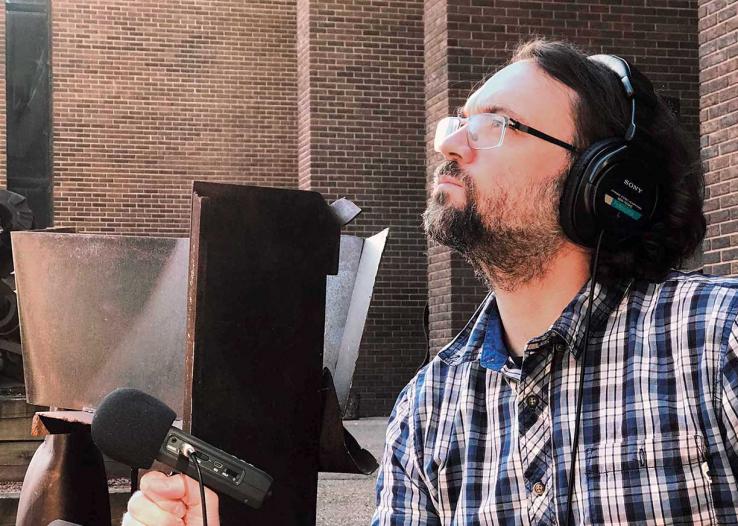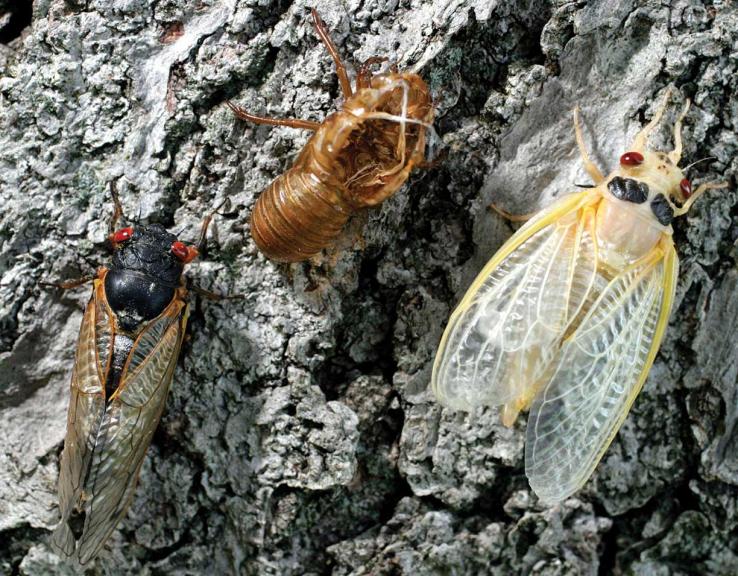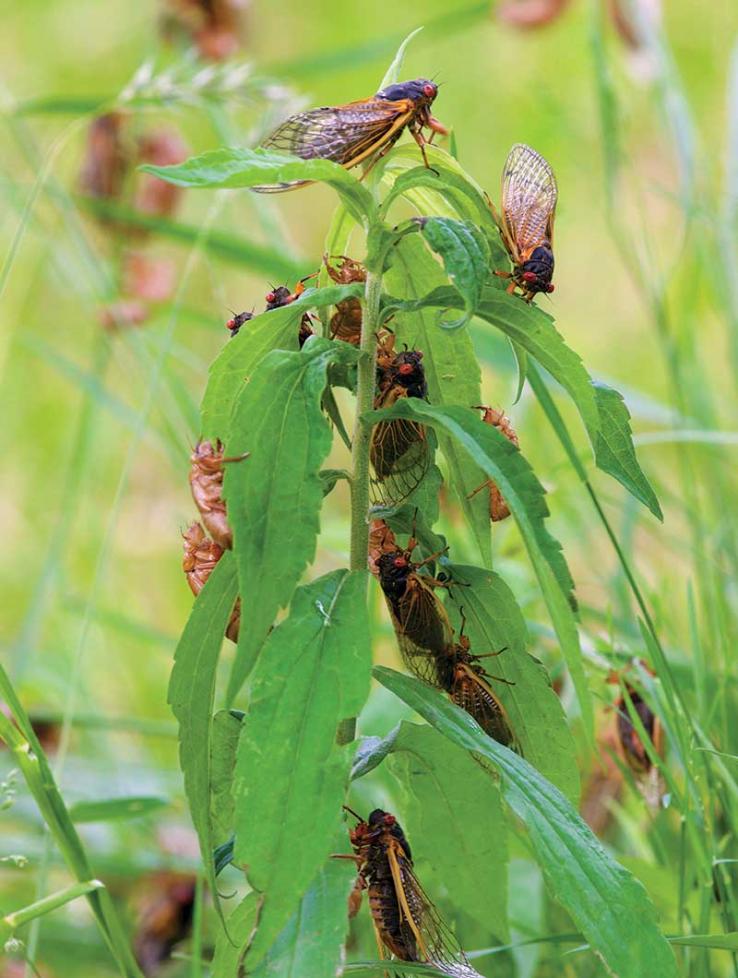A biblical plague? Hardly. Let’s have some respect for the humble cicada. Familiar, in various species, all over the world, the cicada has an old reputation as a friend of scholars. The ancient Greeks, thinking the insects’ music good company for academic discourse, called them soft names like “sweet prophet of summer” and “beloved of the Muses.” Regardless of whether they actually prefer academic settings, cicadas make a definite home each summer on Princeton’s campus, singing from the crowns of trees: loud as a power mower, warm as a cello. Locust is a common, but incorrect, nickname; when European settlers first saw these insects emerge from the ground in the millions, they feared a plotline from the Old Testament had come for them.
The massive brood that is singing this year only comes once every 17 years. Like Keats’ nightingale, which is immortal because the bird has witnessed all of history while living in its own eternal present, always singing the same song, these cicadas sing the same song for every generation that treads the campus paths. In 1885, they sang for high-spirited schoolboys who wore black sweaters year-round and staged regular heists to steal the Nassau Hall bell clapper. In 1919, they sang for a more sober, square-shouldered company of students who had recently returned from the war in Europe.
You must be on campus to hear the cicadas properly. Try playing a recording on Spotify or YouTube or some nature website. Nothing you hear will come close to the layer upon layer of pulsing, buzzing music that the cicada ensemble performs on its open-air stage.
The male cicada does the singing. He sings to find mates, extolling the beauty of his wings, the size of his abdominal cavity, and the strength of his tymbal muscles. But he also cooperates with his romantic rivals to protect the safety of the swarm. In 1970, a team of researchers in Princeton University’s Auditory Research Laboratory figured out why cicadas sing so loudly: to keep away predators. Their volume can reach around 100 decibels, the same as a chainsaw; birds, bats, and squirrels find this volume annoying, and they risk damaging their hearing by exposing themselves to it for too long. “Thus, as cicadas congregate in large numbers for mating,” wrote the researchers, led by James Simmons *69, “the loudness of their sounds drives birds — and virtually all other visible animal life — away.”
The cicada makes his music in much the same way that a human musician plays the cello. Using his tymbal muscles, he pulsates a set of ribbed membranes above a hollow abdominal cavity, just as a cellist manipulates a set of strings stretched over a hollow body. The result is a warm, low, buzzing song.
The female cicada listens and evaluates. When she hears a song she likes, she approaches the singer, flicking her wings in a mating bop of her own, and then deposits eggs in the twigs of bushes and trees. Flea-sized nymphs fall out of the twigs and burrow into the ground, reemerging after 17 years to begin the cycle again.
Princeton’s 17-year cicadas belong to two species, Magicicada cassini and Magicicada septendecim. (A third species is not seen in Princeton, says cicada aficionado Peter Grant, professor emeritus of ecology and evolutionary biology.) They also belong to Brood X, the largest of several broods of cicadas that inhabit the eastern United States. They come outfitted for Reunions season, with wings of orange and black.
In 2004, the last cicada year, alumni at Reunions — specifically, alums who had graduated 17 or 34 years earlier — were talking about their “cicada reunion,” according to Tamara Broderick ’07, who attended the festivities.
That year, members of the Class of 1970, which has kept an insect theme going for decades, marched in the P-rade under their “Seventy-pede,” a centipede costume that has encompassed as many as 70 classmates at once. Gregg Lange ’70, PAW’s online columnist, recalls that “the whole bug theme” started at the class’s 20th reunion. “I was the chair of the Reunions Committee at the time,” he says. “A bunch of the more demented creative types came up with the theme, because of the Dylan thing. The costume for the reunion was a jungle costume for a lepidopterist with pith helmets to go with the jackets, Bermuda style. We carried little bug nets and clickers to make the sound of the cicadas.” The class motto: “In Locust Parentis.”

Also at Reunions in 2004, Scott Smallwood *08, now an associate professor of composition at the University of Alberta, exhibited a music installation that he created from recordings of the cicadas’ song.
“When I moved to Princeton, I knew this was going to be happening, so I was excited about it,” Smallwood says of the cicada emergence. “But I had no idea what I was in store for.”
Smallwood, who carries a tape recorder to record sounds in his environment, realized soon after the cicadas started to emerge that they sounded nothing like the insects he knew. “Anybody who’s been in the South or certain parts of the eastern U.S. has heard the sound of the annual cicadas: that rhythmic shh-shh-shh,” he says. But the 17-year cicadas created a soundscape that he still struggles to describe: They sound like Captain Kirk’s phaser; like the Brooklyn band Mouthus, part of the “noise music” scene; like the late experimental musician Zbigniew Karkowski.
“The sound is unbelievable,” he says. “It was often really hard to tell how far away they were. You knew some of them were really close, but it just all conglomerated into this massive, chaotic cloud.”
Later that year, Smallwood released the music as a concept album. (You can hear it at bit.ly/brood-x-music).
“I have used the sounds in a lot of other contexts, since then,” he says. “They have become part of my vocabulary.”

Superstitions have swirled around these insects since at least the time Europeans first wrote about them. In 1669, a settler in Plymouth Colony named Nathaniel Moreton published a book about the history of New England, which interpreted an emergence of cicadas in 1633 as a prophetic omen of a fever that killed more than 20 people. “[T]here was a numerous company of Flies,” Moreton wrote, “which ... made such a constant yelling noise as made all the woods ring of them, and ready to deaf the hearers; they were not any of them heard or seen by the English in the country before this time: but the Indians told them that sickness would follow, and so it did ... .” In 1705, another historian noted that a swarm of cicadas had emerged in 1676, one of three “ominous presages” in Virginia around that time. He connected these portents with “the Virginia Rebellion,” a bloody settler revolt.
By the 20th century, the periodicity of the periodical cicada was a widely known fact, but people still found ways to argue that cicadas can foretell the future. The insect has orange veins on its wings that form the shape of a “W.” Its return therefore presaged war, people claimed — an easy prediction, since unfortunately war is always about to start somewhere.
Much is still not known for certain about these insects, not least because our window of opportunity to see them comes once a generation. Why do they spend 17 years underground? How do they know 17 years have passed? How did two different species of cicada come to share a 17-year cycle in the first place? Why do those two species share a 17-year cycle in one region and a 13-year cycle in another region?
In 2004, two juniors at Princeton conducted field work among the cicadas in preparation for their senior theses. Marian Bihrle Johnson ’05 tagged 20 cicadas with small radio transmitters and monitored their activity with the help of two research assistants.
“There was a lot of buzz, no pun intended, about the cicadas in the EEB department,” Johnson recalls. “Frankly, the whole campus was energized about the coming of the cicadas because of the lore and almost the biblical proportions of their emergence. I got caught up in that energy.”
Radio tracking allowed Johnson to study how the cicadas choose which trees to sing in, she says: “Nobody really knew how far they traveled during their brief lifetimes.” She learned that they travel only 300 meters — about 985 feet — in the time between when they crawl out of the ground and when they die.
“As I’ve returned to campus in this interval between 2004 and now, I’ve often thought about the construction from the point of view of the cicada habitats,” she says. “As the campus changes, what is happening to the cicada populations? Because when they emerge, they can’t travel very far. It’s not like they can travel to a wooded area off of campus. The vast majority spend their life at the same tree, or they move one tree over.”
That same year, Uta Oberdoerster Rawson ’05 also did field research on cicadas. “My goal was really to have Professor Peter Grant be my thesis adviser,” she says. “I just admire him so much. We met when I was a junior, and he said, ‘You know, there’s this thing happening in the spring. There’s an emergence of Brood X happening — these periodical cicadas. And that’s an incredibly interesting event from an evolutionary perspective.’”
For four weeks, early each morning, Rawson visited the grounds around Nassau Hall, taking measurements of every aspect of the trees she could think of — height, foliage, distance between them.
“I had a little clipboard; the grounds crew helped by measuring some of the tree heights for me,” she says. “It was an eerie, magical time.”
Here is what Rawson learned: First, the only factor that affects where the cicadas sing and lay their eggs is where they emerge from the ground. Periodical cicadas rely on their huge numbers to help protect individuals against predators. She also learned that their wings are adapted to very short flights: “They’re not going to fly across the field. They’re just going to stick to the tree that they came out of and find their mates within that group.”
“They count the years, we think, by measuring the cycles of a tree through their roots,” Rawson says. “In the winter, the root fluid slows down, and then it accelerates when it gets warm and all the leaves turn green. So the nymphs underground are able to count. And then, when the soil temperature reaches a certain level, we think, they all emerge within a two- to six-week window.”
How do the nymphs spend their 17 years underground? Nibbling on the roots of plants. Enjoying themselves.
Today, Rawson works in the Office of the Chief Counsel (OCC) at the Food and Drug Administration. She is on the OCC’s COVID-19 Response Force. She plans to revisit Princeton with her family to hear the cicadas again.
“For me, the sound of the periodical cicada brings back a deep sense of excitement and happiness,” she says. “It brings me back to a time when there were lots of questions and lots of mysteries. I can feel exactly what it felt like to be standing in front of Nassau Hall and seeing all those trees covered in cicadas, and the awe of nature.”
Johnson, too, has been thinking about her college years because of the cicadas’ reunion.
“In 2004, I spent a lot of time thinking about how old I would be when the cicadas returned,” she says. “Because 17 years, it’s a very odd time cycle to think about your life. It doesn’t correspond with a reunion year, it doesn’t really correspond to major decades. But I kind of did this calculation as a 20-year-old junior, just thinking, ‘Huh. I’ll be 37. I wonder where I’ll be. I wonder which of life’s mysteries will have been answered for me.’ And I have to say, over the years, I’ve kind of returned to that at points of introspection, thinking, ‘OK, how close are we to the return of the cicadas? What do I have to show for it?’”
Another alum who says the cicadas are bound into his Princeton memories is Barry McCrea *04, who studied European literature at Princeton.
“The rhythm of the academic year goes very deep — especially when you’re young — very deep into your somatic memory,” he says. “There’s this moment when it starts to get a little bit warm — the end of the year is coming — and the trees burst into bloom on Witherspoon Street. And there’s this slightly sour smell, mixed with the smell of coffee coming out of Small World. For me, it really stirs me up, because it’s the smell of both beginnings and endings.”
The last cicada emergence happened the spring McCrea graduated with his Ph.D., he says: “It really felt like a pathetic fallacy. It was an epochal event in my life, and then bizarrely — it’s hard to think that it’s true — these black-and-orange insects poured out of the earth and sent us off. I’m still not a hundred percent sure that some Princeton scientist didn’t engineer it.”
For my own part, I was a freshman in 2004. That spring, I sent a friend a message that was tipsy with wonder in the way that undergraduate reveries usually are: “As I walked home in the dark at 7:40, all the crowns of the oaks burst into song over my head. The insects had started humming at the same time. The sky between the branches was dark, dark blue, and I couldn’t tell whether the bits of purple in it came from the dead sunset or from the back of my eyes.”
Today, if I like, I can reread books from my undergraduate syllabi. I can get in touch with old teachers or gossip with old friends. But I can’t re-create the feeling of being on that campus — or being of it. Here’s hoping that next year, we can gather once more under the trees and raise our voices in song. Let’s try to return more often than once every 17 years.
Stony Brook University professor Elyse Graham ’07 is the author of You Talkin’ to Me?: The Unruly History of New York English.



